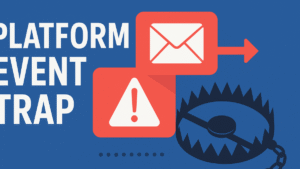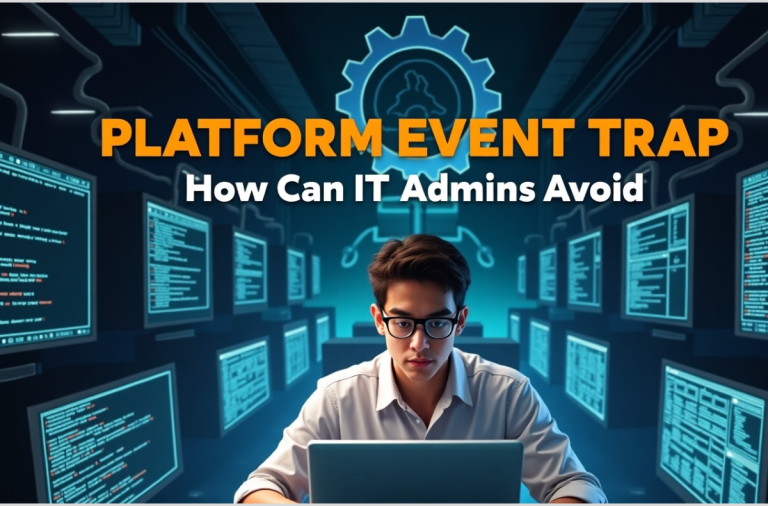How to Avoid the Platform Event Trap Effectively
What Is a Platform Event Trap?
A platform event trap occurs when an occasion-driven system mistakenly makes loops or continuous causes that overload the process. Simply to say one event’s reasons to another one, this cycle controls the reasons for a system. This is routine issues in platforms like salesforce, and other addition management that depends on automated events.
A platform event trap happens when developers don’t set proper management in their event process. For example, an event may cause an update against the well-management. The same event creates repetition at last. This destroys the system resources and leads to serious performance issues.
Platform events are managed for better and real time communication between applications, if not managed carefully, they can become unbalanced. A simple mistake can force multiple factors.
To understand the platform event trap supports manager to design safe event-driven solution, and circular activate and manage the reliable system performance for business processes
How Platform Events Work in Modern Systems
Platform events play an important role in connecting different applications by a real time engagement. There are the types of the event-driven architecture where systems provide updates promptly without relying on continuous API calls or manual management. This helps the business respond faster to change the work flow automatically.
In futuristic systems like salesforce or cloud-based forums a platform event acts as a message that moves between publishers and readers. When something new happens such as a recording update or a procedure of completion, an event is published and promptly sent to the reader’s system or services.
Readers then act on those events by performing specific actions, such as updating information, activating the workflow, or delivering the notifications. That makes the system more authentic and accurate.
To understand how platform events work, architecture design smooth integration and try to avoid the platform event trap. With proper design and following the platform can build smooth reliable response, and flexible system that helps for real-time requirements.
Common Causes of the Platform Event Trap
The platform event trap often happens when architecture builds event systems without proper management rules and limitations. The main issue is circular activating where an event regularly activates, the same event published again and again. This regular loop can slow the system or crashes.
Another main problem is missing filters or situations. When an event begins without proper checking, it moves toward unnecessary activations and repeating actions. This makes the system unstable and harmful to handle.
Weak event structure also has a big role. Using unclear event names or publishing repeating the event confuse the operations system and lead to performance issues.
So, unsettling events are a major issue. When too many events are listed at the same time, it repeats. To avoid the platform event trap architecture must set smart filters, test event logic and monitor the system properly.

Real-World Impact: Why it’s a Serious Issue
The platform event traps a technical problem but it really affects and causes serious damage to system performance and business operations. When events are activated repeatedly or not properly controlled it creates disasters and creates a loop of overload in the server, which delays the process later and even bangs applications. That problem is especially in large scale event driven systems where automation plays important roles.
For business this issue can be costly downtime and data contradictions. For example, duplication in event activation may be problematic or incorrect data shares, making the system unreliable and difficult to operate.
Users may also experience slow response times or incomplete workflows, which slow the overall operation and user trust. Over time these little mistakes become big disasters and then affect the system and customers’ satisfaction.
Avoiding the platform event trap is not just cleaning coding it about safeguarding the reliable eco-friendly digital systems ensures every event adds values although any confusion.
Best Practices to Prevent Platform Event Trap
To stay protected from platform event traps must build a clear strategy. Architectures should firstly define why each event is necessary and ensure it serves a specific objective in an operation. This operation minimizes the confusion and reduces unnecessary projects from publishing that may overload the server. Make proper strategy that flows clean and predictable.
The best way is to use proper filters and conditions to your event activation. This ensures that only the most recent data will process, and avoid unauthentic circulation where events repeatedly activate. Proper management keeps performance sustainable and improves the system.
Proper analyzing and logging are also necessary. By controlling the event traffic and issues architecture can manage the issues earlier and control it before it grows. For future use alert to respond timely.
Always check the event-driven integration in a send box environment before going publically. Tests properly reduce the errors, smooth the forum runs effectively and avoid the common platform event trap.
Final Thoughts on Avoiding the Trap
To secure from platform event trap must be aware about proper planning and good understanding of who the event works. Many architectures fail at this point when they build circular activation or go live with many publications without proper filtering. To handle these issues, we must design a system that works smoothly and efficiently.
To reduce unnecessary lies in building clear event logic. Developers should set severe conditions for when an event should pass or make that reader’s message once only. Proper checking of event catalogs reduces in spotting unusual patterns before any bigger issues.
A strong procedure is compulsory to analyze the catalogs. Testing the event flow in a sandbox environment allows us to analyze the hidden issues before publishing. This process saves time and protects from uncertain failures.
Lastly, avoid the platform event trap meant to say control, clarity and consistency in your architecture. With proper design you can manage scalable, reliable and event-driven systems that perform for long-term achievement. Here is the summary covering the article in a column.
Summary of the Platform Event Trap:
| Types | Details |
| What Is a Platform Event Trap? | Explains how event-driven systems can loop or overload due to improper event managing. |
| How Platform Events Work | Describes how events are published and readers between systems for real-time communication. |
| Common Causes | Lists common problems like circular activations, missing filters, and excessive event volume. |
| Real-World Impact | Shows how the trap reasons system failures, data errors, and performance issues. |
| Best Practices | Recommends solutions such as filtering, monitoring, testing, and clear event catalogs. |
| Final Thoughts on Avoiding the Trap | Highlights careful design, testing, and control to prevent event overloads and loops. |














Post Comment